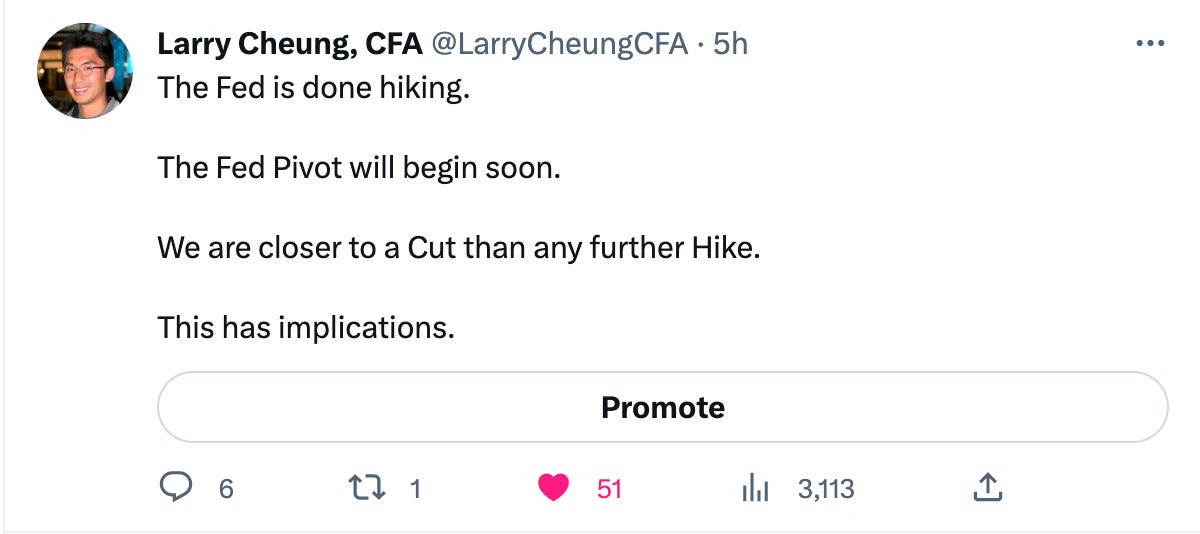5/4 Strat Note: Banking Stocks To Watch For A Tactical Rebound Post PacWest Failure
Strat Note for Members: Banking Stocks Could Bounce Once Stabilization Returns

Members,
Just a quick tactical note. This will be informal and concise.
About 2 Months ago during the SVB crisis back in March, I found opportunities to help our folks here to take advantage of tactical dislocations for swing setups.
With the PacWest crisis, I believe we again have tactical opportunities within the Banking sector.
I listened to the full May FOMC yesterday. Jerome’s tone suggests that he doesn’t believe that the labor market has cooled down enough. He says this despite the Jobs Opening data falling back to 2-year lows.
However, despite his rather hawkish tone, I believe that the Fed is in no position to raise rates further. I think the Fed is done with their rate hikes.
The economy is showing signs of large strain, and markets (being forward looking) will pick this up soon enough.
I believe that late bulls may be forced to sit through an uncomfortable several weeks as a confluence of problems begin to reclaim the market’s narrative.
In a previous note, I discussed that Regionals (in my opinion) offered very little to like (except seemingly low prices).
That has proven correct.
However, large well capitalized banks will recover upon this bout of weakness.
In this note, I discuss a refreshed set of tactical Buy levels based on Financials.
Market Context and Buy Levels Below…
The Context that sets up of the Market’s Frame of Thinking
Yesterday evening, we are witnessing a combination of Qualcomm’s cautious guidance and further strain in Regional Banks as PacWest explores “strategic reviews” of its business.
Qualcomm is a major supplier to smartphones around the globe, and their business gives hints on device demand for Apple as well. At the margin, Qualcomm’s results should reduce the chance that Apple sees a very large beat in their earnings tomorrow.
Apple’s opportunity to outperform in their earnings outcomes comes from their ability to monetize their Services segment due to the sheer size of their user network. However, I don’t believe their iPhone or Mac segments will be as robust.
With Apple near resistance at 170 and macro forces re-aligning to pressure markets, I believe any earnings induced rally by AAPL could get eventually faded. Subsequent gap ups from earnings are an opportunity to reduce the name, in my view.
At the same time, I do not believe we will see any catastrophic selloff in Apple. Big Tech sentiment has been strong due to their incredible cash balances.
For this reason, I believe the winners will not necessarily be the Stock Traders but the volatility sellers who bet that markets stabilize and that the VIX falls.
On the banking side, we are seeing a number of regionals slide up to -30-50% in after-market trading.
As a result, even stalwarts like AXP are seeing immense pressure to trade near RSI 30 levels.
Previous tactical levels on Banking worked, where they bounced temporarily. Remember that once support levels are touched/tested multiple times, they become less and less effective overtime. That’s the nature of markets and support/resistance levels.
Just think of the concept of how many times a support may be tested before it’s finally breached.
Here’s a refreshed list of levels I’m watching where I may be interested again for a tactical long entry (and plan to close out positions upon any profits).
My Financials Focus List:
American Express: Now at 147, or a 2nd Tranche at 143 Region
Charles Schwab: Now at 47 or 2nd Tranche 45 Region
State Street: Now at 67 or a 2nd Tranche at Mid 60 Region
JPM: High 120/Low 130 Region
Interactive Brokers: Now at 71 or a 2nd Tranche at 68 Region
Given the uncertain environment, I wanted to share some ways I think about positioning:
Outright share purchase (for trading)
Selling cash secured puts on short-dated options with 5-8% Strikes out of the Money (My Preference)
Selling cash secured puts on multi-week options with 8-10% Strikes out of the Money
I believe a 2-5% bounce could be coming in the financial names above by the end of next week.
For this reason, implied volatility in many of these names may deflate and Options Sellers may benefit from several scenarios:
The Stock stops dropping
The Stock drops a little bit (but not enough to get to the Strike Price)
The Stock rebounds
The strategy with the greatest upside is outright share purchase. The strategy with less upside is selling the option.
In terms of other ideas mentioned previously (China, Tech, CF/MOS, Among Others), unless I explicitly say that I’ve exited the name (I will clearly say so if I plan to sell them), I still hold them and am letting them work in the background.
Be back with more later. Have to get back to research.
~Larry
Please make sure to read my 4-6 previous letters to understand my fundamental/technical/macro views. Every update builds on top of the others. I write quite frequently now so make sure to read many of my previous editions, which often also include valuable educational content to help you grow as an investor/trader. While I do enjoy sharing my personal journaling of the markets, this is not individual customized financial advice.
Tell friends and family about the work we do - I appreciate you. Spread my methodology where I simultaneously employ Fundamentals, Macro, and Technical analysis into my views to help the good folks find alpha.
Disclaimer: My investment community is not investment, financial, or trading advice, but for educational informational purposes only. I am happy to share my personal opinions which I provide as my personal journal. Trading of any kind of securities involves a lot of risk. No guarantee of any profit whatsoever is made. Investors may lose everything they have. Practice extreme caution. No profit is guaranteed whatsoever, You assume the entire cost and risk of any trading or investing activities you choose to undertake. You are solely responsible for making your own investment decisions. Owners/authors of this publication are NOT registered as securities broker-dealers or investment advisors either with the U.S. SEC, CFTC or with any other securities/regulatory authority. Make sure to consult with a registered investment advisor, broker-dealer, and/or financial advisor.



